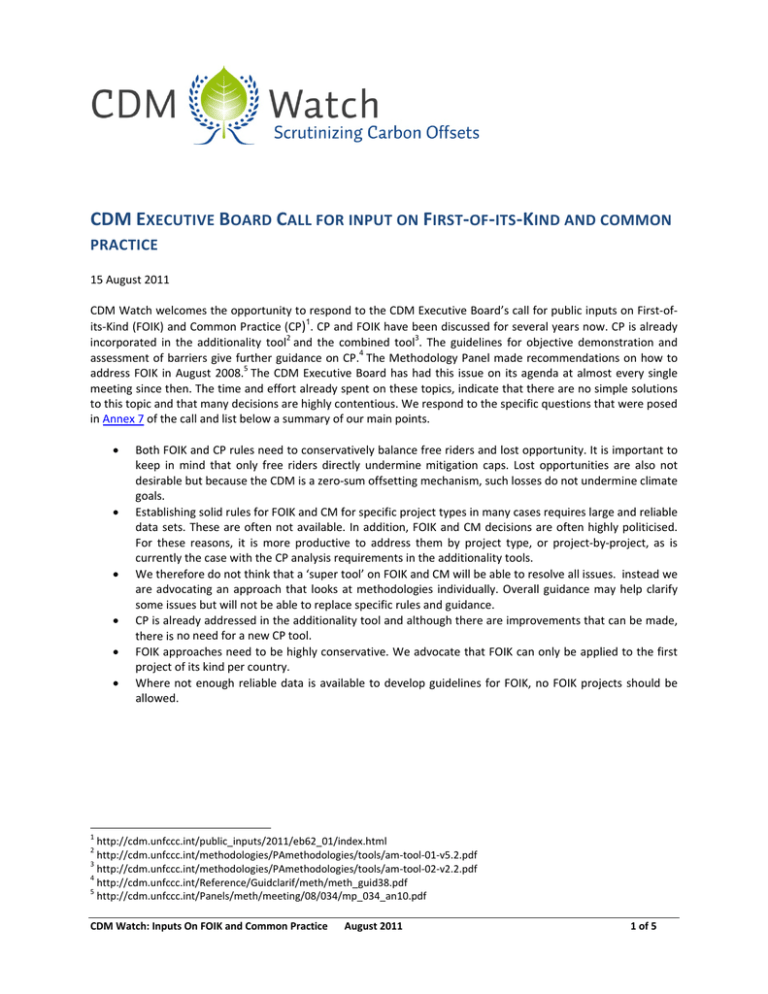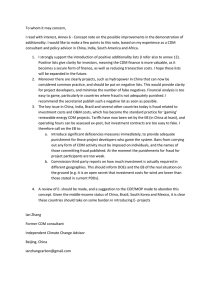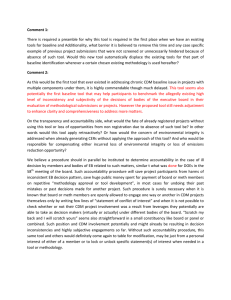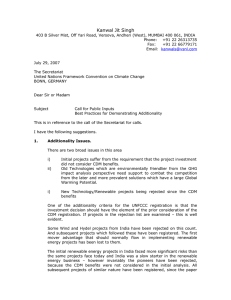CDM E B
advertisement

CDM EXECUTIVE BOARD CALL FOR INPUT ON FIRST‐OF‐ITS‐KIND AND COMMON PRACTICE 15 August 2011 CDM Watch welcomes the opportunity to respond to the CDM Executive Board’s call for public inputs on First‐of‐ its‐Kind (FOIK) and Common Practice (CP)1. CP and FOIK have been discussed for several years now. CP is already incorporated in the additionality tool2 and the combined tool3. The guidelines for objective demonstration and assessment of barriers give further guidance on CP.4 The Methodology Panel made recommendations on how to address FOIK in August 2008.5 The CDM Executive Board has had this issue on its agenda at almost every single meeting since then. The time and effort already spent on these topics, indicate that there are no simple solutions to this topic and that many decisions are highly contentious. We respond to the specific questions that were posed in Annex 7 of the call and list below a summary of our main points. Both FOIK and CP rules need to conservatively balance free riders and lost opportunity. It is important to keep in mind that only free riders directly undermine mitigation caps. Lost opportunities are also not desirable but because the CDM is a zero‐sum offsetting mechanism, such losses do not undermine climate goals. Establishing solid rules for FOIK and CM for specific project types in many cases requires large and reliable data sets. These are often not available. In addition, FOIK and CM decisions are often highly politicised. For these reasons, it is more productive to address them by project type, or project‐by‐project, as is currently the case with the CP analysis requirements in the additionality tools. We therefore do not think that a ‘super tool’ on FOIK and CM will be able to resolve all issues. instead we are advocating an approach that looks at methodologies individually. Overall guidance may help clarify some issues but will not be able to replace specific rules and guidance. CP is already addressed in the additionality tool and although there are improvements that can be made, there is no need for a new CP tool. FOIK approaches need to be highly conservative. We advocate that FOIK can only be applied to the first project of its kind per country. Where not enough reliable data is available to develop guidelines for FOIK, no FOIK projects should be allowed. 1 http://cdm.unfccc.int/public_inputs/2011/eb62_01/index.html http://cdm.unfccc.int/methodologies/PAmethodologies/tools/am‐tool‐01‐v5.2.pdf 3 http://cdm.unfccc.int/methodologies/PAmethodologies/tools/am‐tool‐02‐v2.2.pdf 4 http://cdm.unfccc.int/Reference/Guidclarif/meth/meth_guid38.pdf 5 http://cdm.unfccc.int/Panels/meth/meeting/08/034/mp_034_an10.pdf 2 CDM Watch: Inputs On FOIK and Common Practice August 2011 1 of 5 I. FIRST‐OF‐ITS‐KIND (FOIK) New technologies and practices go through a normal market cycle. In the initial stage early movers adopt the new technology often taking larger risks than if they implemented an established technology. Once the technology has been established, new market participants, so called ‘mainstreamers’ start to adopt the technology. During this phase the technology still usually has a fairly low penetration rate. With time the new technology then becomes common practice (see for example E. Rogers, 1995, Diffusion of Innovations). There are many reasons why a technology has a low penetration rate or has not been implemented in a certain region. Only a few of the reasons for low penetration would render a project ‘additional.’ The interpretation of FOIK therefore needs to be very conservative. We therefore agree with the Methodology Panel’s recommendation for FOIK: “Given that the general definition is applicable to all types of technologies, including very large‐scale industries, a cautious definition of ‘first‐of‐its‐kind’ is provided, which regards a project activity as ‘first‐of‐ its‐kind’ only if no other projects using a similar technology has started commercial operation yet or has been publicly proposed as a CDM project activity.” 6 In other words, only the very first project in the defined geographic area (see below on how to define that area) should be deemed FOIK. A. HOW WOULD YOU NORMALLY DEFINE PREVAILING PRACTICE. AND WHAT INFLUENCES THE CONSIDERATION OF WHETHER SUCH PREVAILING PRACTICE CONSTITUTES A BARRIER? A prevailing practice constitutes a barrier if it is based on the lack of access to capital, technologies and skilled labour. Guidance on what constitutes a barrier is given in the “Guidelines For Objective Demonstration And Assessment Of Barriers.“7 B. IN LIGHT OF THE PREVIOUS ANSWER, IN YOUR UNDERSTANDING, IS A ‘FIRST OF ITS KIND’ PROJECT ALWAYS FACING BARRIERS DUE TO PREVAILING PRACTICE? No. FOIK projects only face barriers as they are defined by the above‐mentioned guidance. C. CONSEQUENTLY, IS THERE A NEED FOR A FOIK CONCEPT IN THE ADDITIONALITY AND COMBINED TOOLS OR CAN THE NORMAL ‐ OR FURTHER IMPROVED ‐ INVESTMENT ANALYSIS OR BARRIER ANALYSIS TEST SUFFICIENTLY OR EVEN BETTER CAPTURE THE ADDITIONALITY OF A PROJECT? The additionality tool already enables project proponents to incorporate the costs for a FOIK project. In other words, the FOIK concept can be addressed through the investment analysis. In other words, the risk that an early mover takes can be translated into monetary costs: e.g. how much it costs to get additional insurance or to train workers in a new technology. Barriers that cannot be addressed through the investment analysis: e.g. major lack in infrastructure cannot be overcome by CDM invectives. For example, many countries are starting to install gas‐fired power plants. This is only possible in areas where natural gas is available and the distribution infrastructure has been put in place. In countries where governments have recently invested in such infrastructure upgrades, gas projects that were to date not feasible now become feasible. If the FOIK rule was interpreted too loosely (e.g. up to 10% of power production) all gas power projects would be deemed additional. D. IS IT SUFFICIENTLY CLEAR WHAT CONSTITUTES A TECHNOLOGY THAT IS FOIK OR IS ADDITIONAL GUIDANCE REQUIRED (E.G. GEOGRAPHICAL LIMITATIONS, METHODOLOGIES , INDUSTRY AND 6 7 http://cdm.unfccc.int/Panels/meth/meeting/08/034/mp_034_an10.pdf http://cdm.unfccc.int/Reference/Guidclarif/meth/meth_guid38.pdf CDM Watch: Inputs On FOIK and Common Practice August 2011 2 of 5 TECHNOLOGY, OTHER DIFFERENTIATING FACTORS...)? HOW WOULD ONE DEFINE THIS GUIDANCE? It is important that further methodology‐specific guidance is developed to specify FOIK requirements. The following definitions are needed: The technology types, for which the barrier ‘first‐of‐its‐kind’ can be used (all technologies or only those defined as ‘novel/innovative/brand new’) Which types of technologies are considered similar and therefore fall under the same FOIK rules. For example renewable energy technologies need to be differentiated by type, size and application. The typology has to be based on distinctions that are commonly used in industry or by other regulations (e.g. the technology benchmarks used in the EU‐ETS) The rational and data on which the technology categorisation is made has to be presented transparently. The decision cannot be based on trying to maximise the number of projects that can claim to be FOIK. The body making these types of technology classifications must not have any conflict of interest. The geographical area to be used for the assessment of the number of similar project activities that have already been implemented. The geographical area has to be chosen according to the type of technology: if the technology is international, homogeneous and traded internationally (such as cement and aluminum), then a global or regional boundary is appropriate. If the technology is heterogeneous and conditions for it vary considerably from location to location, then the geographic boundary can be smaller (e.g country based). One of the main issues in establishing FOIK and CP rules is that it is not possible in many cases to access enough reliable data to develop such guidelines. In these cases no FOIK projects should be allowed. Data gathering efforts should be coordinated with ongoing research and efforts to standardize baselines and benchmarks. E. SHOULD THERE BE TECHNOLOGIES THAT ARE AUTOMATICALLY DEEMED FOIK OR TECHNOLOGIES THAT ARE DEEMED NEVER TO BE FOIK? Each FOIK rule has to avoid creating too many free riders. A global a priori list of FOIK technologies would not be conservative enough to rule out too many free riders. The Methodology Panel often has to review methodologies for technologies that are not widely used yet but can nevertheless be considered common practice. Such methodologies should not be approved and the Methodology Panel should have guidance on how to evaluate and decide on such cases. For example, a methodology for a technology that differs in just one country from a common practice should not be accepted. This could be potentially addressed by requiring that when a methodology is developed for a project type that has been commercially available or established in any area of the applicable geographic scope for less than three years (ie. it uses a new technology or practice), it has to be demonstrated that the project activity faces barriers to its uptake. F. SINCE FOIK IS MEANT TO REFLECT A BARRIER DUE TO A VERY LIMITED AND QUITE UNIQUE APPLICATION OF A (NEW ) TECHNOLOGY, WOULD IT THEN BE NECESSARY TO DEMONSTRATE HOW CDM HELPS TO OVERCOME THIS BARRIER? Yes, as it is currently specified in the additionality tool. CDM Watch: Inputs On FOIK and Common Practice August 2011 3 of 5 G. SHOULD CDM PROJECTS (REGISTERED OR UNDER VALIDATION) CONTINUE TO BE EXCLUDED FROM THE FOIK TEST IN THE LONG TERM? WHAT WOULD BE A REASONABLE TERM? We agree with the guidance given by the Methodology Panel: “[T]he Meth Panel recommends that project participants can claim the barrier ‘first‐of‐its‐kind’ as long as no other project activity employing the same technology within the applicable geographical area has been registered as a CDM project activity or published by the DOE for public comments. This provision is required to prevent many CDM project activities using the same new technology claiming all to be first‐of‐ its‐kind: if several project activities employing the same technology within the applicable geographical area have been submitted to the DOEs for validation before starting their commercial operation, respective project participants could simultaneously claim that no other project activity has started commercial operation and that their project activities are all first‐of‐its‐kind. For this reason, the Meth Panel also recommends to include other CDM project activities in the assessment. If other CDM project activities are not included, this implies that even with a very high penetration rate of a new technology, project activities could still be presented as ‘first‐of‐its‐kind’ if in all other cases of implementation of the technology the CDM was used. It should be noted that if a project activity does not meet the criteria under ‘first‐of‐its‐kind’, the project participants could use any other barriers or the investment analysis to demonstrate additionality of this project activity.” II. COMMON PRACTICE (CP) H. IS THERE A NEED FOR A CP CONCEPT IN THE ADDITIONALITY AND COMBINED TOOLS OR CAN THE NORMAL ‐ OR FURTHER IMPROVED ‐ INVESTMENT AND BARRIER ANALYSIS TESTS SUFFICIENTLY CAPTURE THE ADDITIONALITY OF A PROJECT? The CP analysis is already part of the additionality and combined tools. According to the tool “the common practice analysis is to complement and reinforce the investment and/or barriers analysis.” Experience has shown that it is easy to conduct an investment and barrier analysis in such a way that projects pass those two additionality requirements and can seem to be additional, even if they are not. The CP test adds an additional layer of additionality proof that is very important. It should therefore not be taken out of the additionality or combined tool. I. SHOULD THIS CONCEPT BE INTRODUCED EARLY ON IN THE ASSESSMENT OF ADDITIONALITY OR SHOULD IT CONTINUE TO BE IMPLEMENTED AS A FINAL STAGE OF THE ASSESSMENT ACTING AS A CREDIBILITY CHECK? Project proponents can choose how and in what order they conduct the four steps. The order of how the final results of the additionality analysis is presented does not prevent PPs from conducting these tests in a different order. It is therefore irrelevant how the tests are ordered. J. DO YOU AGREE WITH THE CURRENT APPROACH TO DETERMINE THE CP OF AN ACTIVITY? We agree that the CP analysis should be done on a project by project basis and be assessed by a DOE. Nonetheless, the CP requirements could be strengthened and clarified by adding project type or technology‐specific requirements to each methodology. K. IS THERE A NEED TO BETTER DEFINE WHAT CONSTITUTES A ‘SIMILAR ACTIVITY’ AND THE CRITERIA USED TO IDENTIFY ESSENTIAL DISTINCTIONS (E.G. GEOGRAPHICAL SCOPE, CDM Watch: Inputs On FOIK and Common Practice August 2011 4 of 5 METHODOLOGY, INDUSTRY, TECHNOLOGY, SIZE, LOCAL CIRCUMSTANCES, OTHER CRITERIA INCLUDING THE CURRENT CRITERIA IN THE EXISTING GUIDANCE) It is extremely important that these criteria are defined conservatively for each project type or methodology. This would require a revision of individual methodologies. The order of which methodologies should be revised should be determined by identifying the project types where there are currently only very general requirements that most likely lead to weak CP assessments. The following parameters have to be determined: Type of technologies which are considered CP Which technology types are considered similar and therefore fall under the same CP rules. For example renewable energy technologies need to be differentiated by type, size and application. Geographical area to be used for the assessment of similar project activities that have already been implemented. The geographical area has to be chosen according to the type of technology: if the technology is international homogeneous and traded internationally (such as cement and aluminum), then a global or regional geographic boundary is appropriate. If the technology is heterogeneous and conditions very considerably from location to location, then the geographic boundary can be smaller (e.g country based). L. IS THERE ANY OTHER ALTERNATIVE APPROACH TO DETERMINE THE CP OF AN ACTIVITY? Currently the CP is based on a country or region. It might make sense to define some CP requirements based on the common practice for an international company or industry type seeking to implement a certain project type in country X. A PP might claim that a technology is FOIK in a particular country but that very technology could be business‐as‐usual for the company or in that industry and the reason why no such project has been implemented in country X may be due to infrastructural or economic barriers that have been lifted (e.g. a government installs a natural gas distribution network which enables that country to install natural gas power plants). It would have to be carefully examined in which sectors such a CP classification would make sense. M. SHOULD CDM PROJECTS (REGISTERED OR UNDER VALIDATION) CONTINUE TO BE EXCLUDED FROM THE CP TEST IN THE LONG TERM? WHAT WOULD BE A REASONABLE TERM? No, CDM activities should be included. The exclusion of CDM activities leads to some project types being able to get registered despite clear evidence that they are non‐additional and common practice. For example, hydro power projects in China still easily pass the CP test because existing CDM hydro power projects do not have to be included in the CP test, yet analysis has shows that close to 100% of all new hydro projects in China have applied for CDM. The current rule therefore hides the fact that these projects are business‐as‐usual. N. SHOULD THERE BE A LIST OF ACTIVITIES THAT ARE EXEMPT FROM THE CP TEST? There might be some micro activities that could be exempt from the CP test. Careful examination is needed to establish which micro activities might be exempt and what the rules would have to be in case that activity is part of a PoA. CDM Watch: Inputs On FOIK and Common Practice August 2011 5 of 5 ANNEX: HISTORY OF RELEVANT CDM EXECUTIVE BOARD DECISIONS: 41ST 29. The Board took note of a proposal from the secretariat regarding the guidance on common practice analysis. Due to time constraints the Board could not consider this proposal and agreed to consider it at its next meeting. 47TH 29. The Board agreed to postpone its consideration of guidance on the common practice analysis to its forty‐ninth meeting since no progress on the issue was made during the informal consultations of group of Board members, who were assigned the responsibility as per the decision of Board's forty‐sixth meeting. The Board has requested secretariat to make a new proposal and present to the foty‐ninth meeting of the Board, based upon the inputs received from various Board members, who have been assigned the responsibility to discuss this issue. 54th 26. The Board took note of the recent progress work related to first‐of‐its‐kind and common practice and requested the secretariat, in consultation with selected Board members, to prepare draft guidelines for consideration at its fifty‐sixth meeting. 57th The Board requested the secretariat, with the support of Board members, to further work on the general principles for the development of guidance for project participants on the use of a first‐of‐its‐kind barrier and the assessment of common practice, including the definition of the applicable region, similar technologies and thresholds for penetration rates to be considered by the Board at a future meeting. 60TH 37. The Board considered an update on the work done for the development of guidance on the use of the first‐of‐ its‐kind barrier and the assessment of common practice and requested the secretariat to develop a document to serve as basis for a call for public inputs for consideration by the Board at its next meeting. The Board requested that the document should take into account the following guidance: (a) Work on both separately on the first‐of‐its‐ kind barrier and the assessment of common practice; (b) Use the terms “first‐of‐its‐kind barrier” and “common practice” in the way they are applied in the approved additionality tool; (c) Develop proposals for the application of the terms in the context of the power generation from renewable sources and fuel switch projects in electricity generation for the grid; (d) Identify and focus on other classes of projects where the terms are expected to be easily applicable; (e) Apply a stepwise approach in a possible broadening of applicability of the first‐of‐its‐kind barrier and the assessment of common practice. 61th 38. The Board considered an update on the work related to the use of the first‐of‐its‐kind barrier and the assessment of common practice. The Board requested a small group of members to develop a list of questions to be used in a future call for public inputs, for its consideration by the Board at its sixty‐second meeting. 62ND 34. The Board agreed to launch a call for public inputs on the work related to the use of the first‐of‐its‐kind barrier and the assessment of common practice. The Board also agreed to specific questions for stakeholder inputs, as contained in annex 7 to the report. This call will be open from 18 July 2011 and will close on 15 August 2011. The Board further requested the secretariat to prepare: (a) A note that summarizes the inputs that will be received from the call, taking feedback from the small group of Board members working on the issue; and (b) A new proposal on the use of first‐of‐its‐kind barrier and the assessment of common practice, taking into account the inputs received from the call. CDM Watch: Inputs On FOIK and Common Practice August 2011 6 of 5





